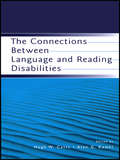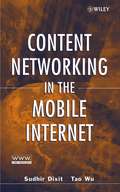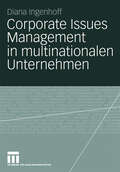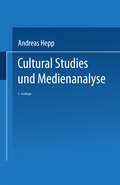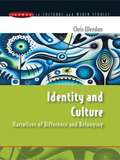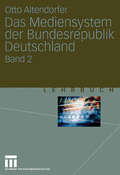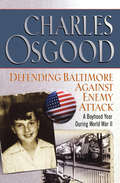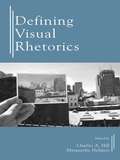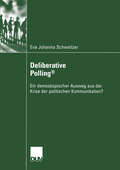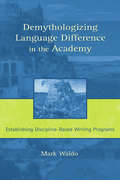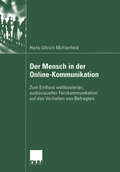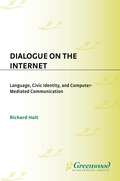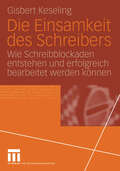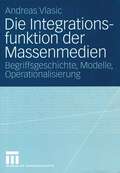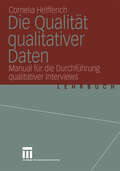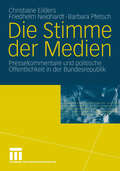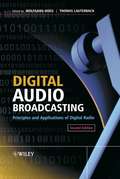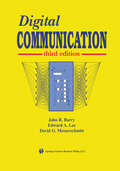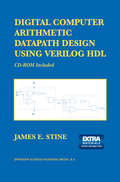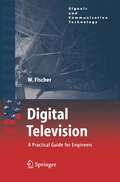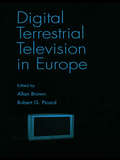- Table View
- List View
The Connections Between Language and Reading Disabilities
by Hugh W. Catts Alan G. KamhiThis is an edited book based on papers presented at a 2003 invitee-only conference under the sponsorship of the Merrill Advanced Studies Center of the University of Kansas. The participants were prominent scholars in the areas of language and reading, and have research programs funded by NIH and other sources. The purpose of the gathering was to discuss theoretical issues and research findings concerning the relationship between developmental language and reading disabilities, specifically looking at neurological, behavioral, and genetic factors. In addition, it discussed other factors contributing to reading difficulties in the middle elementary school years through adolescence and literacy outcomes for children with early language impairments, and how these problems relate to children with dyslexia. The Foreword is written by Reid Lyon, Branch Chief, Child Development and Behavior Branch, NICHD-National Institutes of Health.This book appeals to scholars in the areas of language disorders and reading disabilities, as well as to practicing speech-language pathologists, special educators, and reading specialists. It may also be used in graduate courses designed as seminars in either language disorders or reading disabilities in schools of communication disorders, as well as schools of education--especially special education departments.
Content Networking in the Mobile Internet
by Sudhir Dixit Tao WuPresents a combined view of content and wireless technologies useful to both the industry and academia Offers a good mix of theory and practice to understand the internal working of the wireless/mobile content delivery networks Bridges the gap between the wireless and content research communities Focuses not only on the latest technology enablers for speedier content delivery in the mobile Internet, but also on how to integrate them to provide workable end-to-end solutions
Corporate Issues Management in multinationalen Unternehmen: Eine empirische Studie zu organisationalen Strukturen und Prozessen (Organisationskommunikation)
by Diana IngenhoffDer Wandel der modernen Medienlandschaft zwingt Organisationen, erfolgskritische Themen (Issues) der Stakeholder frühzeitig zu erkennen, adäquat zu bearbeiten und so die Reputation nachhaltig zu stärken. Im Mittelpunkt der erstmalig in Europa durchgeführten Studie steht die Untersuchung der internen Kommunikations- und Koordinationsprozesse von Issues in multinational agierenden Großunternehmen.
Culture and Identity: Narratives Of Difference And Belonging (UK Higher Education OUP Humanities & Social Sciences Media, Film & Cultural Studies)
by Chris WeedonWhere does our sense of identity and belonging come from?How does culture produce and challenge identities?Identity and Culture looks at how different cultural narratives and practices work to constitute identity for individuals and groups in multi-ethnic, ‘postcolonial’ societies. Uses examples from history, politics, fiction and the visual to examine the social power relations that create subject positions and forms of identityAnalyses how cultural texts and practices offer new forms of identity and agency that subvert dominant ideologiesThis book encompasses issues of class, race, and gender, with a particular focus on the mobilization of forms of ethnic identity in societies still governed by racism. It a key text for students in cultural studies, sociology of culture, literary studies, history, race and ethnicity studies, media and film studies, and gender studies.
Das Mediensystem der Bundesrepublik Deutschland: Band 2
by Otto AltendorferDie beiden Bände bieten einen einführenden und umfassenden Überblick über das Mediensystem in Deutschland. Von den rechtlichen Grundlagen über Presse, Fernsehen und Rundfunk bis hin zur Werbung werden alle Bereiche behandelt. Dieses Lehrwerk ist somit für entsprechende einführende Lehrveranstaltungen an der Universität, aber auch zum Nachschlagen wichtiger Hintergrundinformationen geeignet. Jedes Kapitel enthält die wichtigste Grundlagenliteratur für eine gezielte Weiterarbeit.
Defending Baltimore Against Enemy Attack: A Boyhood Year During World War II
by Charles OsgoodFrom beloved broadcaster Charles Osgood, a poignant memoir about one unforgettable childhood year during World War II. Defending Baltimore Against Enemy Attack is a gloriously funny and nostalgic slice of American life and a moving look at World War II from the perspective of a child far away from the fighting, but very conscious of the reverberations. With a sharp eye for details, Osgood captures the texture of life in a bygone era.
Defending Baltimore Against Enemy Attack: A Boyhood Year During World War II
by Charles OsgoodFrom beloved broadcaster Charles Osgood, a poignant memoir about one unforgettable childhood year during World War II.Defending Baltimore Against Enemy Attack is a gloriously funny and nostalgic slice of American life and a moving look at World War II from the perspective of a child far away from the fighting, but very conscious of the reverberations. With a sharp eye for details, Osgood captures the texture of life in a bygone era.
Defining Visual Rhetorics
by Charles A. Hill Marguerite HelmersImages play an important role in developing consciousness and the relationship of the self to its surroundings. In this distinctive collection, editors Charles A. Hill and Marguerite Helmers examine the connection between visual images and persuasion, or how images act rhetorically upon viewers. Chapters included here highlight the differences and commonalities among a variety of projects identified as "visual rhetoric," leading to a more precise definition of the term and its role in rhetorical studies. Contributions to this volume consider a wide variety of sites of image production--from architecture to paintings, from film to needlepoint--in order to understand how images and texts work upon readers as symbolic forms of representation. Each chapter discusses, analyzes, and explains the visual aspect of a particular subject, and illustrates the ways in which messages and meaning are communicated visually. The contributions include work from rhetoric scholars in the English and communication disciplines, and represent a variety of methodologies--theoretical, textual analysis, psychological research, and cultural studies, among others. The editors seek to demonstrate that every new turn in the study of rhetorical practices reveals more possibilities for discussion, and that the recent "turn to the visual" has revealed an inexhaustible supply of new questions, problems, and objects for investigation. As a whole, the chapters presented here demonstrate the wide range of scholarship that is possible when a field begins to take seriously the analysis of images as important cultural and rhetorical forces. Defining Visual Rhetorics is appropriate for graduate or advanced undergraduate courses in rhetoric, English, mass communication, cultural studies, technical communication, and visual studies. It will also serve as an insightful resource for researchers, scholars, and educators interested in rhetoric, cultural studies, and communication studies.
Defining Visual Rhetorics
by Charles A. Hill Marguerite HelmersImages play an important role in developing consciousness and the relationship of the self to its surroundings. In this distinctive collection, editors Charles A. Hill and Marguerite Helmers examine the connection between visual images and persuasion, or how images act rhetorically upon viewers. Chapters included here highlight the differences and commonalities among a variety of projects identified as "visual rhetoric," leading to a more precise definition of the term and its role in rhetorical studies. Contributions to this volume consider a wide variety of sites of image production--from architecture to paintings, from film to needlepoint--in order to understand how images and texts work upon readers as symbolic forms of representation. Each chapter discusses, analyzes, and explains the visual aspect of a particular subject, and illustrates the ways in which messages and meaning are communicated visually. The contributions include work from rhetoric scholars in the English and communication disciplines, and represent a variety of methodologies--theoretical, textual analysis, psychological research, and cultural studies, among others. The editors seek to demonstrate that every new turn in the study of rhetorical practices reveals more possibilities for discussion, and that the recent "turn to the visual" has revealed an inexhaustible supply of new questions, problems, and objects for investigation. As a whole, the chapters presented here demonstrate the wide range of scholarship that is possible when a field begins to take seriously the analysis of images as important cultural and rhetorical forces. Defining Visual Rhetorics is appropriate for graduate or advanced undergraduate courses in rhetoric, English, mass communication, cultural studies, technical communication, and visual studies. It will also serve as an insightful resource for researchers, scholars, and educators interested in rhetoric, cultural studies, and communication studies.
Deliberative Polling®: Ein demoskopischer Ausweg aus der Krise der politischen Kommunikation?
by Eva Johanna SchweitzerEva Johanna Schweitzer untersucht am Beispiel einzelner in der Praxis durchgeführter Deliberative Pollings® Ansatz, Methode und Grenzen dieses Verfahrens mit Blick auf sein Potential, die Krise der politischen Kommunikation zu beenden.
Demythologizing Language Difference in the Academy: Establishing Discipline-Based Writing Programs
by Mark WaldoIn this volume, Mark Waldo argues that writing across the curriculum (WAC) programs should be housed in writing centers and explains an innovative approach to enhancing their effectiveness: focus WAC on the writing agendas of the disciplines. He asserts that WAC operation should reflect an academy characterized by multiple language communities--each with contextualized values, purposes, and forms for writing, and no single community's values superior to another's. Starting off with an examination of the core issue, that WAC should be promoting learning to write in the disciplines instead of writing to learn, Waldo proposes: *housing WAC in comprehensive writing centers independent of any other department; *using dialogue and inquiry rather than prescriptive techniques in the WAC program's interaction with faculty in other disciplines; and *phasing out writing assessment that depends on one test measuring the writing abilities of students from all disciplines. In the process of making his case, Waldo discusses tutor training, faculty consultancy, and multilayered assessment programs. In addition to presenting the theoretical and practical advantages of discipline-based WAC programs, he also offers clear and compelling evidence from his own institution that supports the success of this approach to writing instruction. Demythologizing Language Difference in the Academy: Establishing Discipline-Based Writing Programs will be of interest to writing program and WAC administrators; writing center administrators; graduate students studying composition; and educators and graduate students involved in WAC initiatives, research, and study.
Demythologizing Language Difference in the Academy: Establishing Discipline-Based Writing Programs
by Mark WaldoIn this volume, Mark Waldo argues that writing across the curriculum (WAC) programs should be housed in writing centers and explains an innovative approach to enhancing their effectiveness: focus WAC on the writing agendas of the disciplines. He asserts that WAC operation should reflect an academy characterized by multiple language communities--each with contextualized values, purposes, and forms for writing, and no single community's values superior to another's. Starting off with an examination of the core issue, that WAC should be promoting learning to write in the disciplines instead of writing to learn, Waldo proposes: *housing WAC in comprehensive writing centers independent of any other department; *using dialogue and inquiry rather than prescriptive techniques in the WAC program's interaction with faculty in other disciplines; and *phasing out writing assessment that depends on one test measuring the writing abilities of students from all disciplines. In the process of making his case, Waldo discusses tutor training, faculty consultancy, and multilayered assessment programs. In addition to presenting the theoretical and practical advantages of discipline-based WAC programs, he also offers clear and compelling evidence from his own institution that supports the success of this approach to writing instruction. Demythologizing Language Difference in the Academy: Establishing Discipline-Based Writing Programs will be of interest to writing program and WAC administrators; writing center administrators; graduate students studying composition; and educators and graduate students involved in WAC initiatives, research, and study.
Der Mensch in der Online-Kommunikation: Zum Einfluss webbasierter, audiovisueller Fernkommunikation auf das Verhalten von Befragten
by Hans-Ullrich MühlenfeldHans-Ullrich Mühlenfeld vergleicht die Interviewmodi Face-to-Face, Web-Fragebogen und das persönliche Interview via Desktop-Videokonferenz (IAPI). Er nimmt eine technische und theoretische Analyse der Vor- und Nachteile der neuartigen Methode IAPI vor und zeigt, dass dieses Instrument dem Face-to-Face-Interview sehr nahe kommt und Vorteile gegenüber den bisher üblichen Online-Befragungsmethoden bietet.
Dialogue on the Internet: Language, Civic Identity, and Computer-Mediated Communication (Civic Discourse for the Third Millennium)
by Richard HoltRichard Holt draws on his extensive experience in discourse analysis and Web design to present a picture of the Internet as a potentially powerful tool of civic discourse in the third millennium. Beginning with background on two of the Internet's most prevalent communication forms, email discussion messages and Web pages/sites, the book introduces the concepts of monologism and dialogism. Holt advocates a method of discursive analysis called dual reading, in which Internet utterance is analyzed first monologically and then, dialogically. This method is demonstrated by analyzing email discussions that deal with such varied topics as media, espionage, sexual identity, presidential politics, hate speech, and hate crimes.This volume contains a multidisciplinary approach, involving a wide range of specializations, from computer science to philosophy. It will appeal to students, teachers, practitioners, and lay readers who are interested in Internet communication, politics, and popular culture. In contrast to many of the doom and gloom accounts of the deficiencies of the Internet, it offers a hopeful vision of the Internet as a means of civic discourse.
Die Einsamkeit des Schreibers: Wie Schreibblockaden entstehen und erfolgreich bearbeitet werden können
by Gisbert KeselingWorin bestehen die Schwierigkeiten bei Schreibblockaden und wie lassen sie sich überwinden? Darum geht es in diesem Band. Die Gegenüberstellung der gestörten und ungestörten Prozesse erlaubte es, die Schwierigkeiten zu ermitteln, an denen die blockierten Autoren scheiterten, und daraus auch Gegenstrategien abzuleiten.
Die Inszenierung des Neubeginns: Antrittsreden von Regierungschefs in den USA, Großbritannien, Frankreich und Deutschland
by Klaus StüweErstmals wird mit diesem Band vergleichend dargestellt, welche Funktionen, Rituale und Symbole die Antrittsreden der Regierungschefs in den vier großen westlichen Demokratien Großbritannien, den USA, Frankreich und Deutschland prägen. Untersucht werden die historische Entwicklung, der Entstehungsprozess und die Inhalte der ersten Regierungserklärung. Dabei wird deutlich, welche unterschiedlichen Formen politischer Kommunikation sich in den jeweiligen politischen Kulturen dieser Länder entwickelt haben.
Die Integrationsfunktion der Massenmedien: Begriffsgeschichte, Modelle, Operationalisierung
by Andreas VlasicDie Annahme einer Integrationsfunktion der Massenmedien ist in der Kommunikationswissenschaft fest verwurzelt. Die vorliegende Analyse zeichnet die Ideengeschichte des Integrationsbegriffs nach und zeigt die Verbindung dieses einflussreichen Konzepts zu Disziplinen wie Soziologie oder Politikwissenschaft. Auf Basis eines handlungstheoretischen Ansatzes wird ein Modell der Integrationsfunktion vorgeschlagen, das die Ebene des individuellen Handelns von Akteuren mit dem Einfluss der von ihnen vorgefundenen Strukturen verknüpft.
Die Qualität qualitativer Daten: Manual für die Durchführung qualitativer Interviews
by Cornelia HelfferichTheoretische Überlegungen, praktische Übungen und zahlreiche Textbeispiele für das Verhalten von InterviewerInnen bei der Durchführung qualitativer Interviews, die als Module für selbstorganisierte InterviewerInnen-Schulungen genutzt werden können.
Die Stimme der Medien: Pressekommentare und politische Öffentlichkeit in der Bundesrepublik
by Christiane Eilders Friedhelm Neidhardt Barbara PfetschDer Band stellt Befunde aus einer umfangreichen Analyse der Kommentare überregionaler Tageszeitungen 1994 bis 1998 vor und rekonstruiert damit die Struktur der öffentlichen Meinung in der Bundesrepublik. Themenagenden, Deutungsrahmen und Positionen stehen anhaltend bedeutsamen Konfliktlinien im politisch segmentierten Mediensystem gegenüber.
Digital Audio Broadcasting: Principles and Applications of Digital Radio
by Wolfgang Hoeg Thomas LauterbachNow the standardisation work of DAB (Digital Audio Broadcasting) system is finished many broadcast organisations, network providers and receiver manufacturers in European countries and outside of Europe (for example Canada and the Far East) will be installing DAB broadcast services as pilot projects or public services. In addition some value added services (data and video services) are under development or have already started as pilot projects. The new digital broadcast system DAB distinguishes itself from existing conventional broadcast systems, and the various new international standards and related documents (from ITU-R, ISO/IEC, ETSI, EBU, EUREKA147, and others) are not readily available and are difficult to read for users. Therefore it is essential that a well structured technical handbook should be available. The Second Edition of Digital Audio Broadcasting has been fully updated with new sections and chapters added to reflect all the latest developments and advances. Digital Audio Broadcasting: Provides a fully updated comprehensive overview of DAB Covers international standards, applications and other technical issues Combines the expertise of leading researchers in the field of DAB Now covers such new areas as: IP-Tunneling via DAB; Electronic Programme Guide for DAB; and Metadata A comprehensive overview of DAB specifically written for planning and system engineers, developers for professional and domestic equipment manufacturers, service providers, as well as postgraduate students and lecturers in communications technology.
Digital Communication
by John R. Barry Edward A. Lee David G. MesserschmittThis book concerns digital communication. Specifically, we treat the transport of bit streams from one geographical location to another over various physical media, such as wire pairs, coaxial cable, optical fiber, and radio. We also treat multiple-access channels, where there are potentially multiple transmitters and receivers sharing a common medium. Ten years have elapsed since the Second Edition, and there have been remarkable advances in wireless communication, including cellular telephony and wireless local-area networks. This Third Edition expands treatment of communication theories underlying wireless, and especially advanced techniques involving multiple antennas, which tum the traditional single-input single-output channel into a multiple-input multiple-output (MIMO) channel. This is more than a trivial advance, as it stimulates many advanced techniques such as adaptive antennas and coding techniques that take advantage of space as well as time. This is reflected in the addition of two new chapters, one on the theory of MIMO channels, and the other on diversity techniques for mitigating fading. The field of error-control coding has similarly undergone tremendous changes in the past decade, brought on by the invention of turbo codes in 1993 and the subsequent rediscovery of Gallager's low-density parity-check codes. Our treatment of error-control coding has been rewritten to reflect the current state of the art. Other materials have been reorganized and reworked, and three chapters from the previous edition have been moved to the book's Web site to make room.
Digital Computer Arithmetic Datapath Design Using Verilog HDL
by James E. StineThe role of arithmetic in datapath design in VLSI design has been increasing in importance over the last several years due to the demand for processors that are smaller, faster, and dissipate less power. Unfortunately, this means that many of these datapaths will be complex both algorithmically and circuit wise. As the complexity of the chips increases, less importance will be placed on understanding how a particular arithmetic datapath design is implemented and more importance will be given to when a product will be placed on the market. This is because many tools that are available today, are automated to help the digital system designer maximize their efficiently. Unfortunately, this may lead to problems when implementing particular datapaths. The design of high-performance architectures is becoming more compli cated because the level of integration that is capable for many of these chips is in the billions. Many engineers rely heavily on software tools to optimize their work, therefore, as designs are getting more complex less understanding is going into a particular implementation because it can be generated automati cally. Although software tools are a highly valuable asset to designer, the value of these tools does not diminish the importance of understanding datapath ele ments. Therefore, a digital system designer should be aware of how algorithms can be implemented for datapath elements. Unfortunately, due to the complex ity of some of these algorithms, it is sometimes difficult to understand how a particular algorithm is implemented without seeing the actual code.
Digital Television: A Practical Guide for Engineers (Signals and Communication Technology)
by Walter FischerDigital Television closely examines all present-day TV transmission methods. These include MPEG, DVB, ATSC and ISDB-T. DVD is also discussed. The text covers these subjects in a practical-minded manner. Although mathematical formulations are used, they are in most cases only utilized to supplement the text. The book also contains chapters dealing with basic concepts such as digital modulation or transformations into the frequency domain. A major emphasis is placed on the measuring techniques used on these various digital TV signals. Practical examples and hints concerning measurement are provided. The book starts with analog TV base and signal, continues with MPEG-2 data stream, digital video, and digital audio, and then moves on to compression methods. After an excursion into the digital modulation methods, all the mentioned transmission methods are discussed in detail.
Digital Terrestrial Television in Europe
by Allan Brown Robert G. PicardDigital technology for the production, transmission, and reception of television is expected to replace analogue transmission throughout the world. The timetable for this transition is uncertain and different projections have been made for virtually every country in the world. This book gives the exhaustive details of the issues of this changeover in Europe and elsewhere. The details are placed within the context of the massive changes, which the television industry has been subjected to over the past 25 years.The rollout of digital terrestrial television (DTTV) in Europe is a significant issue for every country included in this survey. It is of such importance because DTTV is the centerpiece of many governments' policies toward making Europe the world leader in new information and communication technologies. These same governments are all wrestling with the issues of how to use the technology in ways that create both commercial and non-commercial value. European perspectives on the social, cultural, and political nature of broadcasting vary significantly from those in other parts of the world and require that the introduction of DTTV should be handled differently to its introduction elsewhere.There are enormous technical, political, and economic aspects to be considered and these vary from country to country in Europe. The two editors bring a perspective to this study as media economists who come to the European scene from other parts of the world. The book covers DTTV in depth, and it also includes discussions of cable, satellite, broadband, and Internet technology for comparison.
